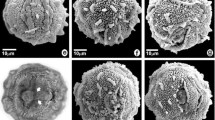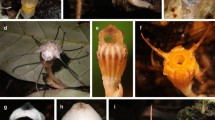Abstract
Passifloraceae shows a huge variability of pollen wall characteristics, most still little described. Passiflora is the largest genus with about 580 species with tropical distribution. Few studies in palynological approaches have described the intine layer which can fill existent gaps. Passiflora L. present four subgenera, from which Passiflora, Astrophea, and Decaloba were described in this study. The pollen wall variations were poorly studied, with the objective of describing the morphological and histochemical structure of Passiflora sporoderm that occurs in South America, aims to supply more pollen wall characters in some contexts. Besides the inference of evolutive trends, we described the number of apertures, type, reticule, and variations of the morphology and sporoderm and we related them with possible evolutive trends for the group. As a result, the pollen grains were not far from the patterns found by the literature, with exceptions. The species of the subgenus Passiflora have fused colpi, varying from 6 to 12 colpi, with type 2-reticulate exine. The species of the subgenus Astrophea have colporus and the species of Decaloba varied as the type of aperture, in which a new type of exine to be considered was found: the type 3. The subgenus Passiflora showed the thickest intine, slim endexine, and absent foot layer. While the species that belong to the other subgenera present a slim intine, the endexine is thick and the foot layer is continuous, among other variable characteristics. The size of the pollen grain seems to be related to the thickness of the intine, and consequently, related to possible pollinators. Through the cluster analysis, we reinforce the affinity of the species to its respective subgenus. To conclude, the analysis of the ultrastructure of the sporoderm and external morphology would be useful for an almost complete interpretation of the variations occurring in the genus, giving more information that the subgenus Passiflora is apomorphic when compared to the other two. The pollen wall characters should be considered on the interpretation of natural history, as well as the phylogenetic relationships of the family, mainly in the Passiflora genus, that has a large number of species distributed across the Neotropical regions.






Similar content being viewed by others
References
Abrahamczyk S, Souto-Vilarós D, Renner SS (2014) Escape from extreme specialization: passionflowers, bats and the sword-billed hummingbird. Proc R Soc B 281:20140888. https://doi.org/10.1098/rspb.2014.0888
Amela Garcia MT, Galati BG, Anton AM (2002) Microsporogenesis microgametogenesis and pollen morphology of Passiflora spp. (Passifloraceae). Bot J Linn Soc 139:383–394. https://doi.org/10.1046/j.1095-8339.2002.00072.x
Amorim JS, Souza MM, Viana AJC et al (2014) Cytogenetic, molecular and morphological characterization of Passiflora capsularis L. and Passiflora rubra L. Plant Syst Evol 300:1147–1162. https://doi.org/10.1007/s00606-013-0952-1
APG IV (2016) An update of the angiosperm phylogeny group classification for the orders and families of flowering plants: APG IV. Bot J Linn Soc 300:1147–1162. https://doi.org/10.1111/boj.12385
Araújo RCM, Santos FA (2004) Palinologia de espécies do gênero Passiflora L. (Passifloraceae) da Chapada Diamantina, Bahia, Brasil. Sitientibus Ser Cienc Biol 4:37–42
Barrios L, Caetano CM, Cardoso CI, Eeckenbrugge GC, Arroyave, JÁ, Olaya CA (2005) Caracterización del polen de especies de los gêneros Passiflora y Dilkea. Acta Agron 54(3):19–23
Corbet SA, Beament L, Eisikowitch D (1982) Are electrostatic forces involved in pollen transfer? Plant Cell Environ 5:125–129
Costa M, Pereira A, Rudall P, Coimbra JS (2013) Immunolocalization of arabinogalactan proteins (AGPs) in reproductive structures of an early-divergent angiosperm, Trithuria (Hydatellaceae). Ann Bot 111:183–190. https://doi.org/10.1093/aob/mcs256
Deginani NB (2001) Las especies argentinas del género Passiflora (Passifloraceae). Darwiniana 39:43–129
Dettke GA, Santos RP (2009) Tipos de aberturas dos grãos de pólen de espécies de Passiflora L. (Passifloraceae). Acta Bot Bras 23:1119–1129
Dettke GA, Santos RP (2011) Morfologia externa, anatomia e histoquímica da antera e grãos de pólen de Passifloraceae do Rio Grande do Sul, Brasil. Rev Bras Biol 9(S1)
Edlund AF, Swanson R, Preuss D (2004) Pollen and stigma structure and function: the role of diversity in pollination. Plant Cell 16(S1):S84–S97. https://doi.org/10.1105/tpc.015800
El-Tantawy AA, Solis M-T, Risueno MC, Testillano PS (2014) Changes in DNA methylation levels and nuclear distribution patterns after microspore reprogramming to embryogenesis in barley. Cytogenet Genome Res 143:200–208. https://doi.org/10.1159/000365232
Erdtman G (1952) Pollen morphology and plant taxonomy – angiosperms. Almqvist & Wiksell, Stockholm
Erdtman G (1960) The acetolysis method. A revised description. Svensk Bot Tidskr 39:561–564
Erdtman G (1969) Handbook of palynology. Munksgaard, Copenhagen
Evaldt ACP, Bauermann SG, Cancelli RR, Acioli M, Neves PCP (2011) Morfologia polínica de Passifloraceae Juss. ex Kunth. no Rio Grande do Sul, Brasil. Rev Bras Biol 9:75–87
Faegri K, Iversen J (1964) Textbook of pollen analysis. Blackwell Scientific Publications, Oxford
Fazal H, Ahmad N, Abbasi BH (2013) Identification, characterization, and palynology of high-valued medicinal plants. Sci World J 2013:1–9
Feuillet C, MacDougal JM (2003) A new infrageneric classification of Passiflora L. (Passifloraceae). Passiflora 13:34–35 37–38
Feuillet C, MacDougal JM (2007) The families and genera of vascular plants. In: Kubitzki K (ed) Passifloraceae. Springer, Berlin
Galen C (1999) Why do flowers vary? The functional ecology of variation in flower size and form within natural plant populations. BioScience 49:631–640
Gerrits PO, Smith L (1983) A new, less toxic polimerization system for the embedding of soft tissue in glycol methacrylate and subsequent preparing of serial section. J Microsc 132:81–85
Gottsberger G, Camargo JMF, Silberbauer-Gottsberger I (1988) A bee-pollinated tropical community: the beach dune vegetation of Ilha de São Luiz, Maranhão, Brazil. Bot Jahrb Syst 109(4):469–500. https://doi.org/10.1590/S1516-89132007000700012
Hansen AK, Gilbert LE, Simpson BB, Downie S-R, Cervi AC, Jansen RK (2006) Phylogenetic relationships and chromosome number evolution in Passiflora. Syst Bot 31:138–150
Herrera CM (1988) Variation in mutualisms: the spatiotemporal mosaic of a pollinator assemblage. Bio J Linn Soc 35:95–125
Heslop-Harrison Y (1977) The pollen–stigma interaction: pollen-tube penetration in Crocus. Ann Bot 41:913–922
Heslop-Harrison J, Heslop-Harrison Y (1991) Structural and functional variation in pollen intines. In: Blackmore S, Barnes S-H (eds) Pollen and spores: patterns of diversification. Clarendon Press, Oxford
Hesse M (2000) Pollen wall stratification and pollination. Plant Syst Evol 222:1–17. https://doi.org/10.1007/978-3-7091-6306-1_1
Janzen DH (1968) Reproductive behaviour in the Passifloraceae and some of its pollinators in the Central America. Behavior 32:33–48
Johansen DA (1940) Plant microtechnique. McGraw-Hill Book, New York
Johnson SD, Steiner KE (2000) Generalization versus specialization in plant pollination systems. Trends Ecol Evol 15:140–143
Judd WS, Campbell CS, Kellogg EA, Stevens PF, Donoghue MJ (2015) A phylogenetic approach. Sinauer Associates, Inc, Sunderland
Knox RB (1984) The pollen grain. In: Johri BM (ed) Embryology of angiosperms. Springer-Verlag, Berlin, pp 197–271
Kohler E (1976) Pollen dimorphism and heterostyly in the genus Waltheria L. (Sterculiaceae). In: Ferguson IK, Muller J (eds) The evolutionary significance of the exine, pp 147–161
Koschnitzke C, Sazima M (1997) Biologia floral de cinco espécies de Passiflora L. (Passifloraceae) em mata semidecídua. Rev Bra Bot 20:119–126
Kraus JE, Sousa HC, Rezende MH, Castro NM, Vecchi C, Luque R (1998) Astra blue and basic fuchsin double staining for plant material. Biotech Histochem 73:235–243
Larson DA (1966) On the significance of the detailed structure of Passiflora caerulea exine. Bot Gaz 127:40–48
May PG, Spears JEE (1988) Andromonoecy and variation in phenotypic gender of Passiflora incarnata (Passifloraceae). Am J Bot 75:1830–1841
Mezzonato-Pires AC, Mendonça CBF, Gonçalves-Esteves V (2015) Pollen morphology of selected species of Passiflora L. (Passifloraceae) from the Atlantic Forest. Acta Bot Bras 29(3):391–399. https://doi.org/10.1590/0102-33062015abb0014
Milward-de-Azevedo MA, Freitas LB, Kinoshita LS (2014) Taxonomy and evolutionary relationships of Passiflora subg. Decaloba supersect. Decaloba sect. Xerogona (Passifloraceae): contributions of palynological, morphological and molecular studies. Acta Bot Bras 28:301–30
Milward-de-Azevedo MA, Baumgratz JF (2004) Passiflora L. subgênero Decaloba (DC.) Rchb. (Passifloraceae) na região Sudeste do Brasil. Rodriguésia 55:17–54
Milward-de-Azevedo MA, Gonçalves-Esteves V, Baumgratz JF (2010) Palinotaxonomia das espécies de Passiflora L. subg. Decaloba (DC.) Rchb. (Passifloraceae) no sudeste do Brasil. Rev Bra Bot 27(4):655–665
Muschner VC, Lorenz AP, Cervi AC, Bonatto SL, Souza-Chies TT, Salzano FM, Freitas LB (2003) A first molecular phylogenetic analysis of Passiflora (Passifloraceae). Am J Bot 90(8):1229–1238. https://doi.org/10.3732/ajb.90.8.1229
Muschner VC, Lorenz-Lemke AP, Vecchia M, Bonatto SL, Salzano FM, Freitas LB (2006) Differential organellar inheritance in Passiflora’s (Passifloraceae) subgenera. Genetica 128:449–453
Pacini E, Hesse M (2007) Pollenkitt – its composition, forms and functions. Flora 200:399–415. https://doi.org/10.1016/j.flora.2005.02.006
Porter-Utley K (2014) A review of Passiflora L. subgenus Decaloba (DC.) Rchb. super section Cieca (Medik.) MacDougal JM and Feuillet C (Passifloraceae). PhytoKeys 43. https://doi.org/10.3897/phytokeys.43.7804
Presting D (1965) Zur morphologie der Pollenkörner der Passifloraceen. Pollen Spores 7:193–247
Punt W, Hoen PP, Blackmore S, Nilsson† S, le Thomas A (2007) Glossary of pollen and spore terminology. Rev Paleobot Palynol 143:1–81
Reis NR, Peracchi AL, Pedro WA, Lima IP (eds) (2007) Morcegos do Brasil. Universidade Estadual de Londrina, Londrina
Richards AJ (1986) Plant breeding systems. George Allen & Unwin, London
Sazima M, Sazima I (1978) Bat pollination of the passion flower, Passiflora mucronata, in southeastern Brazil. Biotropica 10:100–109
Silvério A, Mariath JEA (2013) Comparative structure of the pollen in species of Passiflora: insights from the pollen wall and cytoplasm contents. Plant Syst Evol 300:347–358. https://doi.org/10.1007/s00606-013-0887-6
Snow AA (1982) Pollination intensity and potencial seed set in Passiflora vitifolia. Oecologia 55:231–237
Soares L, Jesus ON, Souza EH et al (2017) Comparative pollen morphological analysis in the subgenera Passiflora and Decaloba. An Acad Bras Cienc 92:2381–2396
Spirlet ML (1965) Utilisation taxonomique dês grains de pollen de Passifloracées. Pollen Spores 7:249–301
Stroo A (2000). Pollen morphological evolution in bat pollinated plants. Plant Syst Evol 25–242
Suárez-Cervera M, Arcalís E, Le Thomas A, Seoane-Camba, JA (2002) Pectin distribution pattern in the apertural intine of Euphorbia peplus L. (Euphorbiaceae) pollen. Sex Plant Reprod. 14:291–298
Varassin IG, Trigo JR, Sazima M (2001) The role of nectar production, flower pigments and odour in the pollination of four species of Passiflora (Passifloraceae) in South-Eastern Brazil. Bot J Linn Soc 136:139–152
Zhang MY, Lu LAHWH, Wang D, Li Z, Blackmore S (2017) Evolution of angiosperm pollen: 4. Basal eudicots. Ann Mo Bot Gard 102:141–182. https://doi.org/10.3417/2015035
Acknowledgements
The authors would like to thank Adriana Carolina Aguirre Morales and Miguel Bonilla Morales for their help in collecting fields in Colombia and the Laboratório de Genética e Evolução, Laboratório de Bioenergia and Centro de Ciências Moleculares e Nanotecnologia da UNICENTRO for support during the image collection. The article is part of the dissertation of the first author that was sponsored by a CAPES master’s degree scholarship.
Author information
Authors and Affiliations
Corresponding author
Ethics declarations
Conflict of interest
The authors declare that they have no conflict of interest.
Additional information
Handling Editor: Peter Nick
Publisher’s note
Springer Nature remains neutral with regard to jurisdictional claims in published maps and institutional affiliations.
Rights and permissions
About this article
Cite this article
Richardo, J., Silvério, A. New trends in Passiflora L. pollen grains: morphological/aperture aspects and wall layer considerations. Protoplasma 256, 923–939 (2019). https://doi.org/10.1007/s00709-019-01350-w
Received:
Accepted:
Published:
Issue Date:
DOI: https://doi.org/10.1007/s00709-019-01350-w




